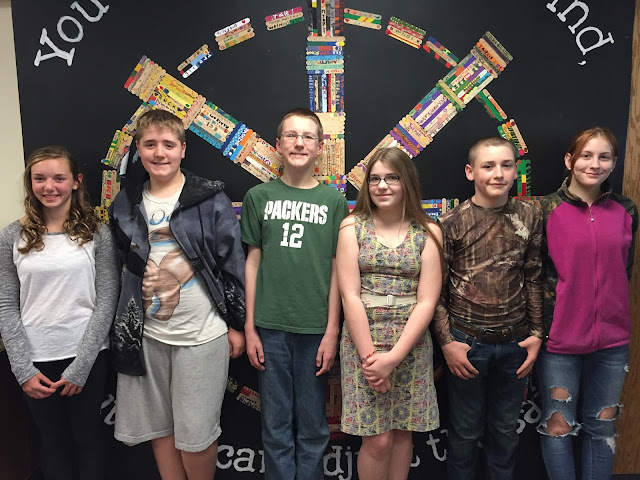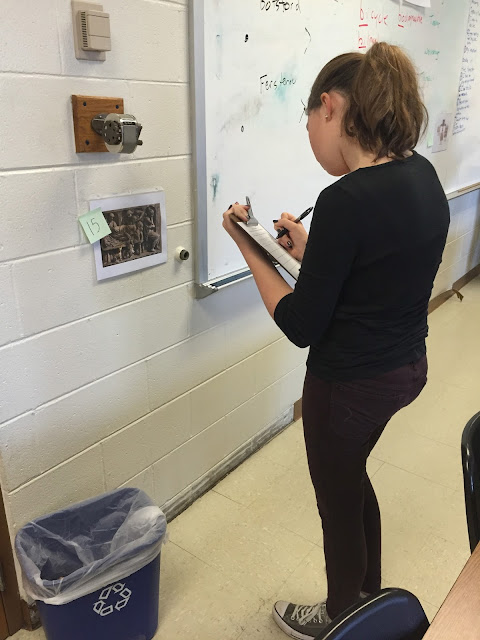KARCHER STAFF BLOG
Student's of the week for
April 18 - April 22
- Kylee McNamara: (Silver)
- Kylee always has a smile on her face and always looks for the chance to help others. She has a generous spirit!
- Delbert Gasser: (Applied Academics)
- Delbert is always friendly and works well with his peers. He is helpful and does a great job participating in class.
- Dylan Thomas: (Hive)
- Dylan put forth awesome effort on his exam this week, displaying responsibility. He has also displayed courage by being a vocal participant in classes.
- Delaney Brien: (Diamond)
- Delaney is a hardworking student that is always representing "The Karcher Way". She has been a quiet leader, but has become an active participant in her classes.
- Brody Richards: (Onyx)
- Brody has a great personality! He always has a smile on his face even when he's running laps on the track in boots. He is personable, polite, and works hard.
- Alyssa Blicharz: (Karcher Bucks)
- Alyssa is a creative student with a real passion for drawing. She is friendly to all and will happily engage in conversations with everyone, especially her teachers.
______________________________________________________________________________
Kudos
_____________________________________________________________________________________________________
- Andrea Hancock was chosen as the KCB STAFF OF THE WEEK! Congrats Andrea and thank you all for continuing to reinforce our 8 character traits.
- Congrats to Rod Stoughton and Nick Buendia for a GREAT performance on Monday night for JazzFest. The students did an amazing job!!!
- Thank you to all academic teachers, special education, teachers, and special educations aides for helping proctor all of the Forward Exams this week. The week went fairly well I thought! Thank you!
- Thank you to all staff for your flexibility this week. I know modified schedules are never ideal but we cannot help state testing requirements and I appreciate all of your flexibility and understanding - thank you.
- HUGE shout out to Steve Berezowitz for all his work behind the scenes with testing - nice job!
- Thank you Andrea Hancock for taking the lead with the Walking Lunches KCB rewards. AND thank all of the staff members who are volunteering to assist with this!!!
- Please say farewell to Faith Trow, special education aide, who will be leaving us with Monday, April 25, being her last day. Faith will be moving back to Kentucky. Good luck Faith!
______________________________________________________________________________
Reminders
__________________________________________________________________________________________________________________________
- Half Day on Tuesday
- Tuesday morning we will be calling students who missed any of their Forward Exams for make-ups.
- Tuesday from 12:00 - 12:30 is our special education aide meeting in the library. Lunch will be provided. Please make sure you communicate with Kim or Jane in regards to attending.
- Tuesday afternoon - Teacher in-service - Building Level.
- We will be working through best practices and setting some ground work for the 2016-2017 school year.
- We will meet in the library at 1:00 - 3:00.
- PLC Wednesday - Standards/Common Assessments
- MAP Testing will begin on May 9th. Marian Hancock sent out information regarding location, etc. See Marian with any questions.
- Walking lunches start on April 25, Monday. See the Google Document below for sign ups. More staff are welcome to join and THANK YOU ALL who volunteered to sign up and assist!
- Walking Lunches - KCB Reward
- Any questions see Andrea Hancock or Matt Behringer
- First Lady Michelle Obama is encouraging everyone to wear your college gear on Tuesday, April 26 to represent where you went to college or your favorite college. So... lets see the gear on Tuesday!
- Looking ahead...
- May 20th will be our last FNL from 5-7:30.
- Please let Mike Jones or Donna Sturdevant know if you are interested and willing to assist with the event.
______________________________________________________________________________
Pictures from the week
_____________________________________________________________________________________________________
Mr. Stoughton and his Vocal Jazz Students this past Monday night at BHS.
Ms. Hoffman and Mr. Block working with their students on a jump rope routine... talk about classroom management at its best right here!
Article of the week: Continuation from last week's article.
Data-Driven Shakespeare
Enhance literature classrooms by using writing to drive conversation.
Enhance literature classrooms by using writing to drive conversation.
3. Give In-Class Feedback on Students' Writing
Feedback is one of the most important drivers to improve critical reading and writing. So why limit feedback to summative essays at the end of a unit? Hadley gives students feedback on their writing every day. Here are three key actions that help her find the time.
Create a monitoring pathway. Most teachers who circulate the classroom to give feedback gravitate toward the students who usually struggle or those who raise their hands for help. The cost of this approach is that few other students receive support. To prevent this problem, Hadley monitors students' writing in a pre-set, strategic order, which she calls her monitoring pathway. Perhaps counterintuitively, she goes to her fastest writers first because they're typically the first ones to get something down on paper. Then she moves on to students who write more slowly, thus giving them some extra time to formulate the beginning to their own answers so that she can respond meaningfully.
Use symbols to give feedback. The second obstacle to giving efficient feedback is the amount of time it takes to interact with each student. Hadley plans a few specific symbols she can routinely use to give feedback on students' writing. Here are some of the symbols she uses as she circulates:
- M=meaning. The student's basic understanding of the text is off. He or she needs to re-read.
- A=argument. The student's main argument is off.
- E=evidence. The student needs more or better evidence.
- Z=zoom in and then zoom out. The student needs to zoom in on each piece of evidence, unpacking words and phrases, and zoom out to explain how this evidence achieves the author's purpose.
Rather than spend 20 seconds explaining that a student needs to look for better evidence, Hadley gives that feedback with a simple code written in the student's page. Twenty seconds shaved off each student interaction translates to reaching more students in a 10-minute span. More students have a chance to improve their answers even before the class discussion begins. Hadley's ability to deliver coded feedback quickly is also greatly enhanced because she already has an exemplar response in hand. Because she knows what she's looking for, it is easier for her to identify the gaps.
Identify the patterns. By using a monitoring pathway and coded feedback, Hadley can more easily identify the patterns of errors that are occurring. On her way through the classroom, she makes notes about overall trends in student understanding, writing the same simple coding on her own paper that she uses for her students. For example, she notices that "E" (lack of high-quality evidence to support an argument) is a weakness in more than half of the students' written responses. During the following discussion, she draws students' attention back to the text and encourages them to cite evidence for the ideas they articulate.
4. Drive the Discourse to What Students Need
By including pre-writing in the lesson, Hadley identifies areas of confusion even before the conversation begins. She can now drive the conversation to what students need to learn, not what they already know.
After students write about Sonnet 65, Hadley calls her class back together. "Students," she says, "we have some solid analyses of the poem, but we're missing some key evidence. I want us to look back at certain lines." She follows by asking targeted questions to clarify the meaning and significance of key words that students misinterpreted or overlooked. "What does 'o'er-sways' mean?" she asks. After a student infers that it means something like "to overtake," Hadley follows with, "So what does it mean that mortality overtakes their power?" At that point students grasp the concept of these seemingly strong and permanent things (brass, stone, earth) being defeated. With that concept solidified, she turns to the last line: "You all noticed that 'black ink' refers to Shakespeare's own writing. But why use the phrase 'shine bright?' What analogy is he making?" Slowly but surely, the students unpack the big idea that a star is heavenly in a way that brass, stone, and sea are of the earth.
As the discussion builds from word meaning to thematic interpretation, Hadley then spurs conversation further by having students analyze one of their peers' responses. "Let's look at Lia's answer," she says, showing the writing sample on the projector. "Do you agree or disagree with her argument? Darius?" Hadley already knows that Darius gave a different answer in his written response. Healthy debate has begun.
Her familiarity with the students' written responses enables Hadley to use the following strategies during the conversation:
- Start from the point of error. Hadley doesn't waste class discussion time on the analyses that students have already done adequately in writing; instead, she uses that time to dive into their errors. This is data-driven discussion at its best: students use discourse to challenge one another to improve their thinking.
- Show-call. By showing examples of student responses and asking the class to react to those answers, Hadley makes it the students' job to unpack misunderstandings so that they build off one another to get to a deeper understanding. She can also leverage strong responses to push the class forward.
- Prompt strategically. Hadley doesn't stop there, though. Rather than just making sure that students are the ones leading the discussion, she monitors which students are doing the talking and when. She asks questions of students she knows are struggling with particular challenges, not students who already know the answers. The conversation is dominated by the students, but it now responds to all students' needs, not just the needs of the extroverted few.
A Data-Driven Cycle of Improvement
Think about the benefits of putting writing first. Although discussion without pre-writing often produces a rich conversation, discussion with pre-writing is more likely to produce meaningful, rigorous learning, in which 100 percent of students grapple with the text and improve their ability to read deeply.
Implement these steps in your classroom, and you've adapted traditional discussion-based learning in a way that will enhance every student's literary understanding. You've increased what each student can do individually, but you've also increased what students can do as a team. The end result is a powerful, data-driven cycle of improvement for literacy: read, write, revise, discuss, revise, and read even more.
When we use student writing to inform literary discussion, we can meet our students exactly where they are at every minute of every class. When we know how far they've already come, we have a great opportunity to help them go even further.





































